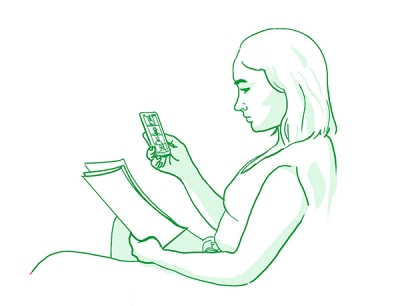Increasing Access to Required Bankruptcy Meetings

How might we increase access to Section 341 bankruptcy meetings, especially for people without legal representation?
In partnership with the U.S. Trustee Program (USTP)
USTP in the U.S. Department of Justice is responsible for overseeing the administration of bankruptcy cases and private trustees. Their mission is to promote the integrity and efficiency of the bankruptcy system for the benefit of all stakeholders–debtors, creditors, and the public.
Context: Dealing with Debt
Bankruptcy is a legal lifeline that helps hundreds of thousands of people and corporations each year to manage debt and pursue a fresh start on their finances. Common reasons people file for bankruptcy include losing a job, medical expenses, and unexpected emergencies.
Moment that Matters: 341 Meeting
Bankruptcy laws require everyone who files for bankruptcy (consumers) to attend a "meeting of creditors" or "341 meeting." The purpose of the meeting is to verify the person's identity and that the information in the bankruptcy petition is correct. A trustee, not a judge, holds the meeting. Creditors may attend, but do not in every case. For consumers, the meeting is a moment in the bankruptcy journey that can feel particularly stressful.
“The (341) meeting with creditors is probably the most stressful thing for consumers - they're fearful because they don't know what to expect.”
- Legal Aid Provider, Colorado
Prior to the COVID-19 pandemic, 341 meetings were held in-person with few exceptions. Participants often missed work, had to arrange for childcare, or incurred other travel expenses to attend the meetings which typically last 10 to 15 minutes. The burdens were greater for some people than others, such as those in rural areas, older adults, people with disabilities, and people from low-income communities.
The Opportunity: Breaking Down Barriers to 341 Meetings
During the COVID-19 pandemic, USTP shifted all 341 meetings from in-person to virtual meetings by phone. The virtual 341 meetings drew more participation from both consumers and creditors, minimized delays, and saved time and money for all involved.
Encouraged by these positive trends, USTP piloted virtual 341 meetings via Zoom for all bankruptcy cases for individuals and families (Chapters 7, 12, and 13) in the states of Colorado, Utah, and Wyoming.
Our Approach: Designing for Access to Justice
During the pilot, USTP collected feedback from trustees and bankruptcy attorneys, but wanted the perspective of consumers. USTP partnered with Access DOJ to facilitate a human-centered design process to hear from legal aid providers who regularly work with people unable to afford legal assistance. Access DOJ also reviewed access to justice research and innovations on virtual hearings.
Learn: What We Heard
Access DOJ organized a listening session with eight legal aid providers across seven locations in Colorado (both urban and rural) who support low-income people through the bankruptcy process.
The legal aid providers found that virtual 341 meetings significantly reduce the burdens associated with in-person meetings (time, money, effort, and other resources). Additionally, virtual 341 meetings help close the justice gap: legal aid providers could help more people because they no longer needed to travel long distances to attend 341 meetings.
They also identified three key pain points for low-income people without a lawyer:
-
Lack of access to internet and technology. Many low-income people struggle to find secure internet and technology to participate in the virtual 341 meetings. It is common for consumers to join in their car on a cell phone.
-
Uncertainty about what to expect. In-person 341 meetings, while less convenient than virtual, gave consumers a chance to watch cases while they waited their turn. Knowing what to expect reduced anxiety. The legal aid providers often encouraged their clients to arrive early. With virtual meetings, consumers only see their own session.
-
Need for more accessible information: Legal aid providers often simplify and break down the guidance about 341 meetings to make it more manageable for their clients. For consumers without a lawyer, the lack of added support may leave them even less prepared.
Create: Identifying Actionable Ideas
USTP and Access DOJ then brainstormed ideas to improve the experience of the virtual 341 meetings and address the problems raised by the legal aid providers.
-
How might we provide other ways for people, especially those without legal representation, to understand what to expect during the 341 meetings?
-
How might we ensure USTP materials are clear and easy to understand for consumers from all backgrounds, especially those without a legal background or legal representation?
In response, USTP is developing videos of mock 341 meetings for Ch. 7, 12, and 13 cases to help consumers know what to expect. They are also planning to revise guidance for consumers to make it easier to understand.
Evaluate: Collecting Feedback
By mid-2024, USTP expects virtual 341 meetings by Zoom to be the standard practice nationwide. USTP will continue to invite and incorporate feedback from stakeholders.
What our USTP colleagues said about the experience:
“It was very helpful to receive first-hand feedback from legal aid attorneys about the practical questions and difficulties their clients face accessing and interfacing with the Zoom platform."
– USTP Staff
“Hearing the legal aid attorney's real life Zoom experiences, particularly in the rural areas [was helpful]."
– USTP Staff
Special thanks to The Lab at OPM as well as the legal aid providers who gave feedback.
What's Next?
For more information about this project, please contact accesstojustice@usdoj.gov.

 U.S. Department
of Justice
U.S. Department
of Justice